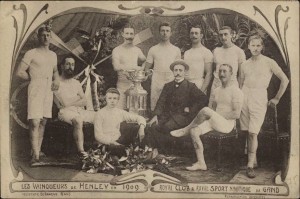Olympians have usually achieved great success in sports, but such success does not always translate to other fields, nor does it guarantee happiness in one’s life. Unfortunately a number of Olympians were unable to deal with the realities of everyday life and chose to end their own. Here is the list of Olympians who have committed suicide.
[table]
Athlete,Nation(s),Sport(s),Era,Notes
Bill Agee,USA,ATH,1928,Committed suicide by slashing his wrist.
John Albrechtson,SWE,SAI,1968-76,
Percy Almstedt,SWE,SAI,1920,Committed suicide by shooting himself.
Charles Aman,USA,ROW,1904,
Alfred Annan,USA,GOL,1904,
Yevgeny Babich,URS,ICH,1956,Committed suicide by hanging himself.
Eugène Balme,FRA,SHO,1908,
Heidi Becker-Ramlow,GDR,DIV,1972-76,
Yevgeny Belosheykin (DNS),URS,ICH,1988,
Ahmet Bilek,TUR,WRE,1960,
Edith Bonlieu,FRA,ASK,1956,Committed suicide as member of the Order of the Solar Temple.
Franco Bontadini,ITA,FTB,1912,Committed suicide after a disappointment in love.
Erich Borchmeyer,GER,ATH,1932-36,
Hugo Borja,MEX,BAS,1936,Committed suicide after his daughter died of an infection; date unknown
Günter Böttcher,FRG,HAN,1976,Committed suicide in a hospital.
Enrico Bovone,ITA,BAS,1968,
Walter Brödel,SAA,FEN,1952,
Jürgen Brümmer,FRG,GYM,1988,Committed suicide by jumping from a bridge after having killed his son.
Ricardo Cardoso,BRA,JUD,1988,Committed suicide in 1991 after a love disappointment.
Edwin Everett Codman,USA,ART,1932,
Richard Corts,GER,ATH,1928,
Ivan Viscount d’Oyley,USA,FEN,1900,Died of a self-inflicted gunshot wound.
Sigi Denk,AUT,CYC,1972,Committed suicide by hanging.
Jacques Dimont,FRA,FEN,1968,
Christophe Dupouey,FRA,CYC,1996-00,
Knut Torbjørn Eggen,NOR,FTB,1984,Committed suicide. Noted of him that he “had come to the point of life where he was more afraid to live than to die”
István Énekes,HUN,BOX,1932,
Jackson Fear,AUS,ARC,1996,
Ragnar Fogelmark,SWE,WRE,1912,
Lucien Gaudin,FRA,FEN,1920-28,
Oskar Gloeckler,GER,ART,1928-32,
Daan de Groot,Ned NED,CYC,1952,
David Guttman,SWE,ATH,1912,Committed suicide by hanging himself.
Jerry Heidenreich,USA,SWI,1972,
Claudia Heill,AUT,JUD,2004-08,Fell from the sixth floor of her flat. It is possible that she committed suicide per original press reports.
Gabriel Hernández,DOM,BOX,1996,He committed suicide by hanging (aged 27) nine days after his last bout against Ralph Monday.
Lutz Hoffmann,GDR,GYM,1980,
Robert Howard,USA,ATH,1996-00,Committed suicide after murdering his wife.
Herbert Huber,AUT,ASK,1968,Committed suicide by hanging.
Yelena Ivashchenko,RUS,JUD,2012,Jumped from her apartment window which was on the 15th floor.
Peter Jaks,SUI,ICH,1988-92,Committed suicide by train.
Hamilton Jukes,GBR,ICH,1924,
Jo Kaiser,GER,ATH,1960,
Anneliese Kapp,GER,DIV,1936,
Kentaro Kawatsu,JPN,SWI,1932,
Per Kinde,SWE,SHO,1920,Committed suicide by hanging himself.
František Kobzík,TCH,ROW,1936,Committed suicide to avoid capture during World War II.
Yoshio Kojima,JPN,ATH,1956,
Clive Longe,GBR,ATH,1968,Committed suicide after murdering his girlfriend.
Frank Mackey,USA,POL,1900,Committed suicide – shot himself while suffering from a terminal illness.
Kersten Meier,FRG,SWI,1972,Committed suicide by jumping from a bridge.
Eugenio Monti,ITA,BOB,1956-68,
Mika Myllylä,FIN,CCS,1992-98,
Takeichi Baron Nishi,JPN,EQU,1932-36,Possibly committed suicide during the Battle of Iwo Jima.
Marco Pantani,ITA,CYC,2000,
Dušan Pašek,TCH,ICH,1984-88,Committed suicide by shooting himself.
Víctor Peralta,ARG,BOX,1928,Committed suicide; shot himself while suffering from terminal prostate cancer
Nils Persson,SWE,SAI,1912,Committed suicide by hanging himself.
Jeret Peterson,USA,FRS,2002-10,Died of a self-inflicted gunshot wound to the head; found in Lambs Canyon (Utah).
Antonio Pettigrew,USA,ATH,2000,Committed suicide by an overdose of pills containing diphenhydramine.
Dan Pippin,USA,BAS,1952,
Vladimír Podzimek,Tch TCH,SKJ,1984,Committed suicide by hanging himself.
Andrey Prokofyev,URS,ATH,1980,Committed suicide by hanging himself.
Pierre Quinon,FRA,ATH,1984,
Fausto Radici,ITA,ASK,1976,Committed suicide by shooting himself with a handgun.
Rhoda Rennie,RSA,SWI,1928,
Guy Revell,CAN,FSK,1964,
Jesús Miguel Rollán,ESP,WAP,1988-04,Died after a fall from a balcony of a rehabilitation clinic where he was treated for depression – possibly he committed suicide.
Ludwig Count von Salm-Hoogstraeten,AUT,TEN,1912,Committed suicide by jumping to avoid capture by Nazis.
Stephen Scherer,USA,SHO,2008,Committed suicide by shooting himself.
Thomas Schleicher,AUT,JUD,1996,Committed suicide while in prison.
Shamil Serikov,URS,WRE,1980,
Christine Smith,AUS,ASK,1964,
Boris Strel,YUG,ASK,1980-84,
Doc Strong,USA,WRE,1936,Committed suicide in a jail cell where he sat for public drunkenness.
Willy Sulzbacher,FRA,FEN,1900,Committed suicide by shooting himself.
Darren Sutherland,IRL,BOX,2008,
Gholam Reza Takhti,IRI,WRE,1952-64,Officially he committed suicide but a lot of sources mention theories about being murdered for his political activities.
Hidemitsu Tanaka,JPN,ROW,1932,
Harold Thomas,NZL,BOX,1932,Committed suicide by jumping from a train few hours after his fiancee’s death.
Adán Torres,ARG,ATH,1948,Committed suicide upon becoming disabled after being struck by a vehicle – date unknown.
Fritz Traun,GER,ATH/TEN,1896,
Kokichi Tsuburaya,JPN,ATH,1964,
Ernst Udet,GER,ART,1936,Committed suicide – shot himself after years of alcoholism and drugs
Vladimír Vávra,TCH,WRE,1928,
Sammy Wanjiru,KEN,ATH,2008,Committed suicide after being found in love triangle by his wife.
Billy Ward,AUS,BOX,2012,
Mike Whitmarsh,USA,BVO,1996,
Percy Williams,CAN,ATH,1928-32,
John Wood,CAN,CAN,1968-76,
Hiromi Yamafuji,JPN,CYC,1964,
Ikuko Yoda,JPN,ATH,1964,
Masami Yoshida,JPN,ATH,1984-92,
[/table]


